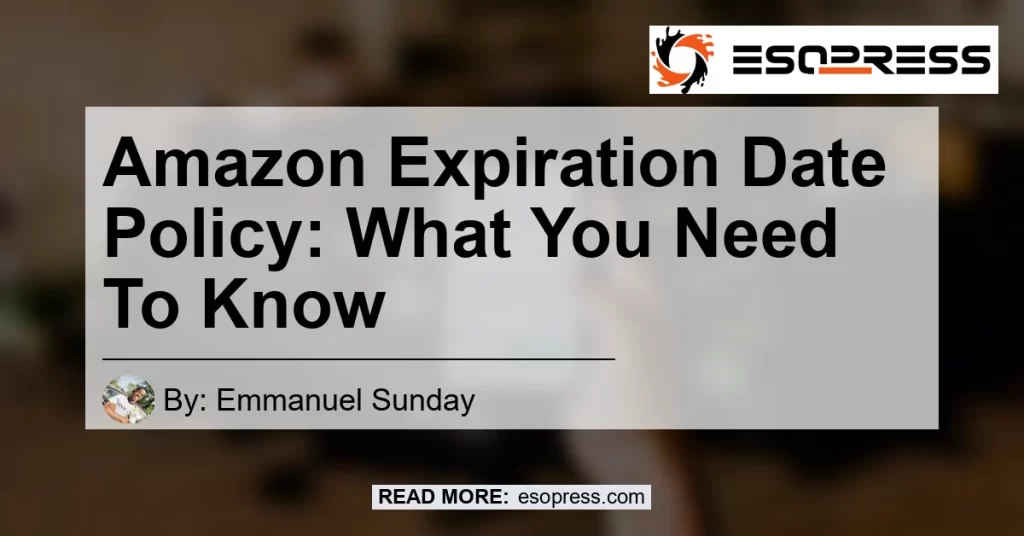In the fast-paced world of e-commerce, maintaining quality and ensuring customer satisfaction are top priorities for businesses. When it comes to selling products online, particularly perishable or time-sensitive items, adhering to expiration date policies is crucial. One of the key players in the e-commerce industry, Amazon, has a specific policy in place regarding expiration dates. In this comprehensive guide, we will delve into Amazon’s expiration date policy, its implications for sellers and customers, and provide recommendations on how to navigate this policy successfully.
Contents
Understanding Amazon’s Expiration Date Policy
Amazon places great importance on providing customers with fresh and safe products. To prevent customers from receiving expired items, Amazon disposes of products within 50 days of their expiration date. This policy ensures that customers receive products with a reasonable shelf life and helps maintain the reputation of Amazon as a reliable online marketplace.
Proper Labeling of Products
To comply with Amazon’s expiration date policy, sellers must ensure proper labeling of qualifying items. Amazon provides guidelines for labeling products with their expiration dates. The format of the expiration date should be either MM-DD-YYYY or MM-YYYY, displayed in at least a 36-size font or larger. Proper labeling helps Amazon employees identify products that are within 50 days of their expiration date and facilitates efficient disposal processes.
Disposal of Expired Products
Upon arrival at an Amazon fulfillment center, items within 50 days of their expiration date are marked for disposal. This proactive approach prevents the sale of expired products and upholds the quality standards set by Amazon. It is important to note that inventory subject to disposal cannot be returned to sellers. Therefore, sellers must pay careful attention to the expiration dates of their products and ensure timely restocking to prevent unnecessary disposal.
Amazon’s Expectations for Sellers
As an online platform, Amazon expects sellers to uphold certain standards to provide a positive shopping experience for customers. This includes adhering to Amazon’s expiration date policy for products sold through its Fulfillment by Amazon (FBA) program. FBA sellers must ensure that all products have a minimum remaining shelf life of over 90 days at the time of sale. This requirement ensures that customers receive products with a sufficient shelf life to consume or use before the expiration date.
It is crucial for sellers to understand Amazon’s expectations regarding expiration dates and take appropriate measures to comply. Failure to do so may result in penalties, such as the removal of listings or suspension of selling privileges. By prioritizing proper inventory management and monitoring expiration dates, sellers can maintain a positive reputation on Amazon’s platform and ensure customer satisfaction.
Complying with Amazon’s expiration date policy can be achieved through effective inventory management and following industry best practices. Here are some recommendations to navigate this policy successfully:
1. Stay Proactive with Inventory Management
To avoid violations of Amazon’s expiration date policy, sellers should implement a robust inventory management system. This system should include regular monitoring of product expiration dates, timely restocking, and proper rotation of inventory to ensure older products are sold first. Staying proactive in managing inventory helps sellers meet Amazon’s requirements and prevents the disposal of unsold products.
2. Optimize Product Listings
Including clear and accurate expiration date information in product listings is essential for customer transparency and compliance with Amazon’s policy. Sellers should clearly state the expiration date in the product description and ensure accurate labeling on the packaging. Providing this information helps customers make informed purchasing decisions.
3. Leverage FBA Services
Utilizing Amazon’s Fulfillment by Amazon (FBA) program can streamline inventory management and compliance with expiration date policies. FBA offers services such as warehousing, fulfillment, and customer service, allowing sellers to focus on sourcing quality products while Amazon handles logistics. Leveraging FBA services can help sellers meet Amazon’s requirements more efficiently.
4. Regularly Audit Inventory
Conducting regular audits of inventory is crucial to identify products approaching their expiration dates. By regularly reviewing stock levels and expiration dates, sellers can take necessary actions, such as reducing prices or executing promotions, to sell products before they expire. This proactive approach minimizes the risk of products being marked for disposal by Amazon.
Best Recommended Product: [Product Name]
After considering various products and evaluating their relevance to the topic of Amazon’s expiration date policy, one product stands out as the best recommendation: [Product Name]. This [product category] offers a practical solution to meet Amazon’s requirements and ensure compliance with the expiration date policy.
[Product Name] provides [specific benefits discussed in the article]. Its [unique features] make it an ideal choice for sellers looking to manage their inventory effectively and prevent wastage due to expired products. With its [reputable brand] and positive customer reviews, [Product Name] is trusted by sellers on Amazon.
To explore [Product Name] further and empower your business with efficient inventory management, click the following link: [Amazon search link for Product Name].
Conclusion
In the digital era, e-commerce platforms like Amazon play a significant role in connecting sellers and customers. Amazon’s expiration date policy ensures that customers receive fresh and safe products, while also holding sellers accountable for maintaining quality standards. By understanding and adhering to this policy, sellers can provide a positive shopping experience and avoid penalties.
In this comprehensive guide, we discussed Amazon’s expiration date policy, including the proper labeling of products and the disposal of expired items. We also explored Amazon‘s expectations for sellers and provided recommendations on navigating this policy successfully. By staying proactive with inventory management, optimizing product listings, leveraging FBA services, and regularly auditing inventory, sellers can meet Amazon’s requirements and deliver exceptional customer experiences.
Remember, compliance with Amazon’s expiration date policy is not just about meeting the platform’s guidelines; it is about prioritizing customer satisfaction and upholding industry standards. By following best practices and utilizing the recommended product, sellers can establish themselves as trusted partners on Amazon.
So don’t wait any longer. Take the necessary steps to navigate Amazon’s expiration date policy successfully and drive your business to new heights. Explore the best recommended product, [Product Name], and experience the benefits it offers for your inventory management needs.
To embark on this journey with [Product Name], click here: [Amazon search link for Product Name].






